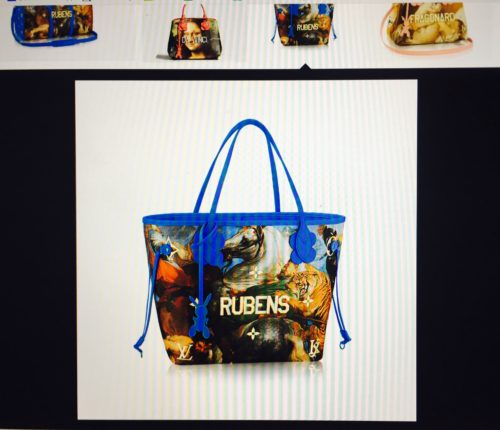Every time a Louis Vuitton x Artist collaboration rolls out, I go through an emotional journey: from the initial shock that wears off to ambivalence to final acceptance, and maybe appreciation (except for the Chapman Brothers collaboration, which I loved from the start). Back in April, when I first saw the Jeff Koons x LV collaboration in Hong Kong, I was appalled. The collection was part of the large window display at the flagship LV store at Landmark, a shopping arcade in Central Hong Kong; it was an unavoidable, conspicuous and mandatory stop on my way to and from work. I felt visually assaulted every time I walked past it. I was startled by the way the designs came out, not because I wasn’t used to seeing paintings taken out of their standard museum settings and imprinted onto bags, (‘been there, done that’ with the museum totes) but by how inexpensive and kitsch they looked. So, as you can imagine how shocked I was when LV announced they were dropping more designs from the LV x Jeff Koons Master collection in October. Enough is enough!
In the initial launch of the collection in April 2017, Jeff Koons took famous works from five legendary painters—Vincent Van Gogh, Leonardo Da Vinci, Jean-Honoré Fragonard, Peter Paul Rubens, and Titian—and stretched them across some of Louis Vuitton’s most popular bags, like the Speedy, Neverfull, and Keepall. With a ‘subtle’ touch, Koons emblazoned the artist names in gold capital letters across the front, and matched the bag’s handles in a plastic acrylic colour palette to the paintings’ undertones. In this second instalment, Louis Vuitton x Koons added an additional six artists: François Boucher, Claude Monet, Paul Gaugin, Nicolas Poussin, Édouard Manet and J.M.W Turner.

But constantly relooking at the bags, (involuntarily), I have come to accept them, in a way. Kitschy as they might be, I must admit they are congruous and loyal to the Jeff Koons brand-name. Kitsch is characteristic of Koons’ work, and it is his way of appropriating mundane, ephemeral items and transforming them into ‘art’.
In an interview with The New York Times, Mr. Koons declares that he hopes people looks at this collaboration as his continued effort to “erase the hierarchy attached to fine art and old masters.” By removing everyday objects such as vacuum cleaners and shampoo polishers from the household and placing them into the museum setting, he has re-contextualized these dull objects into expensive ‘artwork.’
Now, collaborating with LV, Koons is turning his thesis into a two-way street. Instead of just transforming commonplace objects into artwork, he is taking the most irreversible, unchallengeable works of art, (i.e. old masters that have been consecrated by museum establishments), and commodifying them, thereby transforming these works of art into functional items that can be owned by anyone. Is he successful in breaking down the hierarchy attached to fine art and old masters? Hard to say, but at least this time round instead of converting commodity into art, he is rebranding art as commodity. After all, what comes around goes around.
It has all come full circle, and this justification is as far as my appreciation for the bags will go. One last note: be prepared for more bags to come from this collection, because Koon’s Gazing Ball Series reinterpreted as many as 40 old master paintings.
By Lily Mu















